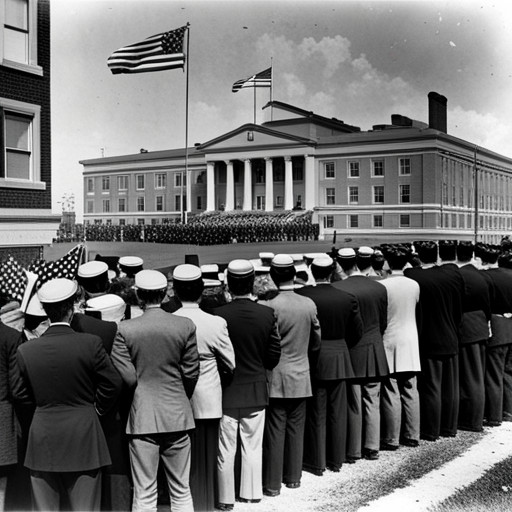Unraveling The Governments Decisions in Handling the Camp Lejeune Case
This article delves into the intricate governmental decisions surrounding the Camp Lejeune case.

It dissects initial responses, examines evolving strategies, and evaluates public reaction's influence on these choices.
The aim is to glean lessons from this analysis that could contribute to potential policy changes in future situations of similar nature.
Key Takeaways
- Authorities initially denied water contamination and health risks, leading to a significant delay in taking action and addressing the issue.
- The government's strategies in the Camp Lejeune case initially focused on investigation rather than communication, but increasing external pressure led to greater decisional transparency and public involvement.
- Public outcry and demands for accountability influenced the government's actions, leading to a shift towards greater transparency, investigation, and resolution.
- Lessons from the Camp Lejeune case highlight the need for regulatory oversight, prompt preventive measures, consideration of decision-making structures and conflicts of interest, and careful management of public sentiment in crisis response.
The Background of the Camp Lejeune Case

The Camp Lejeune case emerged from a situation of widespread water contamination at a United States Marine Corps base in North Carolina, which provoked significant public health concerns and legal actions. A critical exploration into Lejeune's history reveals that the contamination began as early as 1953 when volatile organic compounds (VOCs), including benzene, vinyl chloride, and trichloroethylene were found in two water treatment facilities serving the base.
The sources of these VOCs were attributed to various industrial activities within the base and fuel leakage from underground storage tanks. It is estimated that between 500,000 to one million people may have been exposed to this contaminated water until corrective measures were implemented in 1987. The effects entailed by such exposure are grave, with potential health consequences ranging from birth defects and infant mortality to cancers and neurobehavioral effects.
Studies conducted showed associations between contaminants present in Lejeune's drinking water supply and increased incidence of several diseases among former residents. These findings led affected individuals to seek legal redress against the U.S government for negligence and failure to warn about the risks associated with consuming contaminated water.
In response, Congress approved healthcare benefits for affected veterans and their families through legislation passed in 2012 known as the Honoring America's Veterans and Caring for Camp Lejeune Families Act. Nevertheless, questions remain regarding how regulatory oversights occurred despite evident risks posed by these industrial activities over such an extended period.
Analyzing the Government’s Initial Response

Initial responses of the authorities to the situation require a thorough analysis, with particular attention directed towards their immediate actions and strategies. In the case of Camp Lejeune, response criticism has been targeted at these initial reactions, particularly due to instances of initial denial from governmental bodies.
The onset of the crisis saw an initial denial by the authorities responsible for managing environmental health risks at Camp Lejeune. Evidence suggests that despite early signs pointing towards potential water contamination and associated health risks, there was a significant delay in acknowledging this issue. This delay is often attributed to a lack of urgency in addressing emerging evidence or potentially an attempt to downplay possible negative implications.
This initial denial had consequential effects on subsequent actions taken by government entities. It delayed necessary interventions and resulted in exposure to harmful substances for inhabitants over extended periods. The absence of prompt preventive measures further exacerbated the health impact among those residing within Camp Lejeune.
However, it is critical not only to critique but also understand why such response patterns occur within governing institutions when faced with crises like Camp Lejeune's. A comprehensive understanding would necessitate considering factors such as institutional hierarchy, decision-making structures, and any potential conflicts of interest that may have influenced response strategies.
The Evolution of the Government’s Strategies in the Case

Evolutionary changes in the strategies adopted by official bodies in the situation under scrutiny warrant careful examination, focusing on how these approaches were modified over time and their efficacy. The Camp Lejeune case demonstrates significant strategic shifts, with governmental bodies altering their approach to handling this complex issue.
Initial strategies involved minimal public engagement and transparency, seemingly prioritizing investigation over communication. However, increasing external pressure triggered a strategic shift towards greater decisional transparency and public involvement. This shift was evident in the subsequent release of comprehensive reports detailing the contamination extent and potential health implications for those affected.
Despite these efforts, criticism mounted regarding the government's perceived reticence to acknowledge its culpability fully. Furthermore, gaps remained concerning the provision of appropriate healthcare for impacted individuals and compensation measures. Henceforth, another strategic shift emerged - an attempt to address these criticisms through legislative measures designed to provide medical care for affected individuals.
Yet, this approach also faced challenges: bureaucratic hurdles hindered efficient implementation and questions arose concerning sufficiency of provided services relative to individual needs. Moreover, concerns persisted regarding full disclosure of all available information – a crucial aspect of decisional transparency.
Public Reaction and Impact on Government’s Decisions

Public outcry and sentiment significantly influenced the strategies adopted by official bodies in response to this situation, underscoring the role of societal pressure in shaping policy actions. The Camp Lejeune case served as a glaring example of this phenomenon. As information regarding contamination issues surfaced, public reaction was characterized by indignation and demands for accountability. This profound public outcry placed substantial pressure on government bodies, compelling them to act decisively.
In navigating these turbulent waters, the decision consequences became an increasingly crucial consideration for governmental entities. It was evident that any attempt to downplay or ignore the issue could exacerbate public discontent and potentially lead to political fallout. Thus, a more proactive stance was adopted with a focus on investigation and resolution.
The shift in strategy implied greater transparency about past missteps and future corrective measures. A comprehensive review was initiated into historic practices at Camp Lejeune along with efforts aimed at rectifying identified lapses. The urgency attached to these actions demonstrated how powerfully public sentiment can sway policymaking processes.
However, while societal influence undeniably shaped official responses in this instance, it also highlighted potential pitfalls such action could engender if not carefully managed. Decisions made under intense public scrutiny risk being reactive rather than strategic; they may serve immediate expectations but fail to address underlying systemic issues accurately.
Lessons Learned and Potential Policy Changes

Reflecting on past events, several key lessons have emerged that can inform potential policy changes. The handling of the Camp Lejeune case provides a unique examination into the intricacies of policy-making and its implications. It is evident that transparency, timely action, and inclusive decision-making processes are essential components in handling public crises effectively.
One critical lesson from the Camp Lejeune case is the importance of transparency in government actions. In situations involving public health risks, withholding information or delaying responses can exacerbate public concerns and lead to mistrust. Thus, it becomes crucial for policies to ensure immediate disclosure of risk-related information to maintain public trust.
Another vital lesson is the necessity for swift and decisive action. Delayed responses not only worsen health impacts but also increase legal liabilities and public backlash. To mitigate these consequences, it is imperative to implement lessons learned promptly into new policies that mandate quick response measures during such crises.
Lastly, an inclusive decision-making process involving all stakeholders has significant policy implications. Such an approach fosters consensus-building, reduces conflicts of interest, and enhances the legitimacy of decisions made.
Frequently Asked Questions
What Is the Current Health Status of the Affected Individuals From the Camp Lejeune Case?
The health status of individuals affected by the Camp Lejeune case varies, with many experiencing long-term impacts. Healthcare provisions have been implemented to manage ongoing physical and psychological conditions resulting from this incident.
Are There Any Similar Cases in Other Military Bases That Are Being Investigated?
Investigations into similar base contaminations are ongoing, reflecting an increase in military accountability. Cases like Fort Detrick and Kadena Air Base exhibit parallels to the Camp Lejeune incident, underscoring a broader pattern of environmental negligence.
What Specific Steps Did the Government Take to Address Public Outrage in Relation to the Case?
In response to public outrage, governmental accountability was demonstrated through a series of measures including investigations, the provision of health benefits to affected individuals, and compensation measures for victims of the Camp Lejeune case.
How Has the Case Influenced the Government’s Decision-Making in Other Environmental Health Crisis?
The case has significantly shaped policy implications and crisis management in environmental health crises, leading to more proactive strategies, stringent regulations, and improved transparency to prevent similar incidents and address public concerns effectively.
Are There Any Ongoing Legal Proceedings Related to the Camp Lejeune Case?
Legal implications continue to reverberate from the Camp Lejeune case, with ongoing legal proceedings primarily aimed at determining compensation measures for those affected by the environmental health crisis on the military base.
Conclusion
In conclusion, the government's handling of the Camp Lejeune case presented a complex interplay of strategies, public reaction, and policy implications.
The lessons learned from this experience offer valuable insights for future policy development. A critical evaluation reveals potential areas for improvement in initial responses and strategy evolution to ensure more effective management of similar situations in the future.
This case underscores the importance of transparency and swift action in maintaining public trust during crisis resolution.

This post has been generated by AI and was not reviewed by editors. This is Not legal advice. Please consult with an attorney.



